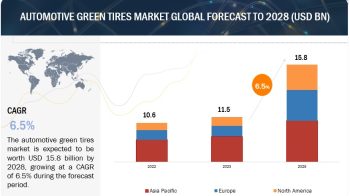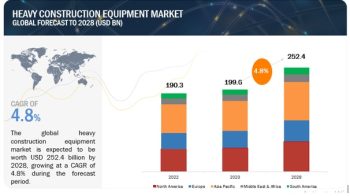Polyphenylene is a class of high-temperature plastics with properties such as thermal stability, dimensional stability, and chemical & flame resistance. Polyphenylene are used in applications that demand high temperature and chemical resistance for efficient functioning. Polyphenylene have become an important part of highly dominant end-use markets, and the growth of the polyphenylene market is driven the demand for these resins form applications requiring lightweight and high-performance materials.
Download FREE PDF Brochure: https://www.marketsandmarkets.com/pdfdownload.asp?id=126530081
The global polyphenylene market is projected to reach USD 4.99 billion by 2023, at a CAGR of 8.2% between 2018 and 2023. These resins are increasingly used in various end-use industries due to their properties such as high chemical resistance and dimensional stability, among others. Moreover, these resins find application in filter fabrics. Polyphenylene can withstand a temperature of around 180°C and are preferred over other materials due to their resistance to heat and chemicals. All these are the key factors driving the polyphenylene market. However, the high cost of polyphenylene than conventional materials limits their use in high-end applications, thus inhibiting their market growth.
Key companies profiled in this report include Toray Industries (Japan), Solvay (Belgium), Tosoh Corporation (Japan), DIC Corporation (Japan), Kureha Corporation (Japan), LG Chem (South Korea), Celanese Corporation (US), Saudi Arabia Basic Industries Corporation (Saudi Arabia), China Lumena New Material (China), and Ensigner (Germany). Rapid urbanization and increasing population in developing regions have encouraged companies to adopt several business strategies to stay competitive in the global polyphenylene market between 2014 and 2017. Therefore, the companies have adopted expansions, acquisitions, and new product launches as their key growth strategies.
Toray Industries (Japan), one of the largest polyphenylene resin manufacturers in the world, has adopted expansions as its key strategy. The company is continuously expanding its polyphenylene sulfide (PPS) business globally to maintain its market position. Toray is focusing on electronics & electrical and automotive, among various other industrial applications, to expand its polyphenylene resin business. For example, in October 2017, the company decided to set up a new production facility at its Hungarian production unit for the manufacturing of resins. This move will help the company to expand its polyphenylene resin business footprint in the European region.
DIC Corporation (Japan) has considered expansions as its key strategy to staying competitive in the global polyphenylene resin market. Its state-of-the-art technology for the production of polyphenylene resins is its biggest strength. The company offers polyphenylene sulfide products and its variants under its FZ brand. In September 2017, the company announced the expansion of its production capacity of polyphenylene sulfide (PPS) resin at its Komaki Plant in Japan’s Aichi Prefecture. DIC plans to invest around USD 7.2 million towards this expansion.
Polyphenylene are a class of high-temperature plastics possessing properties such as thermal stability, dimensional stability, and chemical & flame resistance. This report estimates the market size for polyphenylene based on type, end-use industry, application, and region. The global polyphenylene market is projected to reach USD 4.99 billion by 2023, at a CAGR of 8.2% between 2018 and 2023. The growth of the polyphenylene market can be attributed to its increasing demand from automotive and aerospace industries and rise in use in the filter bag application. This is due to its properties, such as high dimensional stability, peak temperature, and high chemical resistance, among others. However, its high cost as compared to other conventional materials is a major factor restraining the growth of the market.
APAC led the polyphenylene market in 2017, followed by North America and Europe. The demand for these resins is high in China. The economic growth of China is the main factor for the high consumption of polyphenylene. The growing automotive industry has led to an increased demand for polyphenylene in the country. The polyphenylene market in the Asia Pacific region is expected to grow at the highest CAGR during the forecast period. This growth is driven by the government’s support and strong manufacturing base, and the rising investments in the polyphenylene production in developing economies such as China, India, and South Korea, among others. Europe and North America are relatively mature markets as compared to the rest of the world.
The polyphenylene sulfide type segment is projected to grow at the highest CAGR during the forecast period. Polyphenylene sulfide (PPS) is a polymer consisting of an aromatic ring, which is linked by sulfides. PPS is a chemical structure made from benzene and sulfur. It is resistant to high heat, flame, and chemicals. The polyphenylene sulfide type segment is expected to lead the market during the forecast period. Its inherent flame retardancy and good electrical insulation properties make it an ideal polymer for the automotive, and electronics & electrical industries.
Based on end-use industry, the automotive segment is expected to lead the polyphenylene market and electronics & electrical segment is projected to grow at the highest CAGR between 2018 and 2023. Several polyphenylene manufacturers, such as Toray and Solvay, are setting up new production plants and introducing innovative technologies in line with the increasing demand for polyphenylene from end-use industries such as automotive, and electrical & electronics. All these factors are expected to fuel the growth of the polyphenylene market during the forecast period.
Based on application, the engineering plastic segment led the overall polyphenylene market in 2017. This segment is projected to grow at the highest CAGR between 2018 and 2023. The growth of this segment can be attributed to the increasing preference for engineering plastics in automotive, aerospace, and electrical & electronics industries, as they possess good mechanical and thermal properties as compared to other plastics. This has led to an increased demand for lightweight materials that are used in aforementioned end-use industries and are driving the growth of this market.


